If you spend a lot of time on the history of nuclear weapons, you see a lot of mushroom clouds photographs. There were over 500 atmospheric nuclear tests conducted during the Cold War, and most of these were photographed multiple times. (There were over 50 dedicated cameras at the Trinity test, as one little data point.) The number of unique photographs of nuclear explosions must number in the several thousands.
And yet, most of the time we seem to reach for the same few clouds that we’ve always reached for. How many books, for example, have this shot of the Castle Romeo mushroom cloud on their cover? Romeo was an American H-bomb test from 1954, 11 megatons in yield. It gets used, however, for all sorts of things — like the Cox Report’s 1999 allegations about China stealing advanced (much lower-yield) thermonuclear warhead designs, or illustrating Soviet nuclear weapons, or illustrating (most incorrectly) nuclear terrorism (which would not look like this at all). It’s a great photo (dramatic, red, well-framed), but it’s not a generic mushroom cloud — it is a really high yield weapon, and arguably ought to only be used to illustrate very high yield weapons.
OK, I’m a pedant about this kind of thing. I get annoyed with poorly-used mushroom cloud photos, and repetitive photos, because there are just so many good options out there if the graphic designers in question would just search beyond the first thing that comes up when you Google “mushroom cloud.” But re-using known clouds is not as bad as, say, mistaking a fake, computer-generated mushroom cloud for a real one.
This photo is often labeled as the “Tsar Bomba” cloud and it is not even an actual photograph of a nuclear test — it is a CGI rendering, and not even a very good one. I don’t think you even have to be a nuke wonk to recognize that, and that people’s CGI-savvy would be better than this, but I guess not. An animated version is circulating on YouTube — the physics is all wrong regarding the fireball rise, the stem, etc., and the texturing is off. Apparently a lot of people have been fooled, though. 1 There is film of the actual Tsar Bomba explosion, and one can readily appreciate how different it is.
The above photo is also sometimes labeled as the “Tsar Bomba,” and was recently featured on the cover a book about the British atomic bomb, labeled as a British thermonuclear weapon. It is actually a French nuclear weapon, specifically the test dubbed “Licorne,” a 914 kiloton thermonuclear shot detonated in 1970 at the Fangataufa atoll in French Polynesia. I do admit finding the confusion about this one amusing, especially when it is mislabeled as a British test. (As an aside: I do not blame authors for the photos on their book covers, because I know they often don’t have anything much to do with the cover images.)
There are actually four shots from this same test that I don’t think most people realize are of a sequence, showing first the brief condensation cloud that formed in the first 20 seconds or so (which exaggerates the width of the actual mushroom cloud, similar to the famous Crossroads Baker photograph), and then tracks the mushroom cloud as it rises. When you resize them to the same scale (more or less), you can see that they are not four different shots at all, just differently timed photographs of the evolution of a single shot’s mushroom cloud:
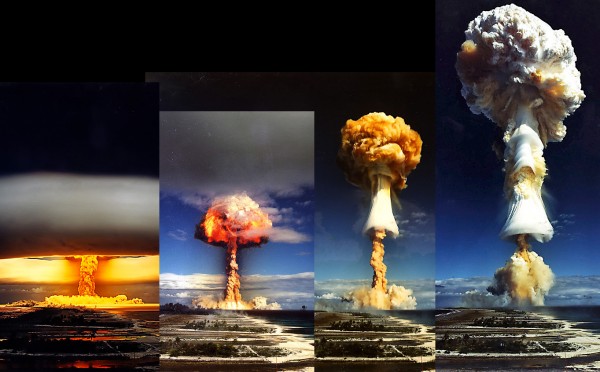
Source: SonicBomb.com galleries
There is also a film of the test, though the quality isn’t that great. The whole sequence represents less that a minute of the bomb detonation; as I’ve noted previously, most of our photos of mushroom clouds are from the first minute or so after their detonation, and they can get pretty unfamiliar if you watch the cloud evolve for longer than that.
Other clouds that have gotten overused (in my opinion) include Upshot-Knothole Grable, Crossroads Baker, and Upshot-Knothole Badger.
Does it matter that we re-use, and sometimes mis-use, the same mushroom clouds over and over again? In a material sense it does not, because the people who use/misuse these clouds are really not using them to make a sophisticated visual or intellectual argument. Rather, they have chosen a “scary mushroom cloud” image for maximum visual effect. And these fit the bill, except maybe the fake one, which will turn off anyone who can spot a fake.
But it does represent the way in which a lot of our cultural understanding of nuclear weapons has stagnated. The same visuals of the bomb, over and over again, mimic the same stories we tell about the bomb, over and over again. Culturally, there is a deep “rut” that has been carved in how we talk and think around nuclear weapons, a sort of warmed-over legacy of the late Cold War. I am sometimes astounded by how deep, and how deeply held, this rut is — on Reddit, for example, people will fight vehemently over the question of dropping of the atomic bomb, sticking exclusively to positions that were argued about 20 years ago, the last time this stuff was “hot.” They aren’t aware that the historiography has moved quite a distance since then, because you’d never know that from watching or reading most historical discussions of the bomb in mainstream media.
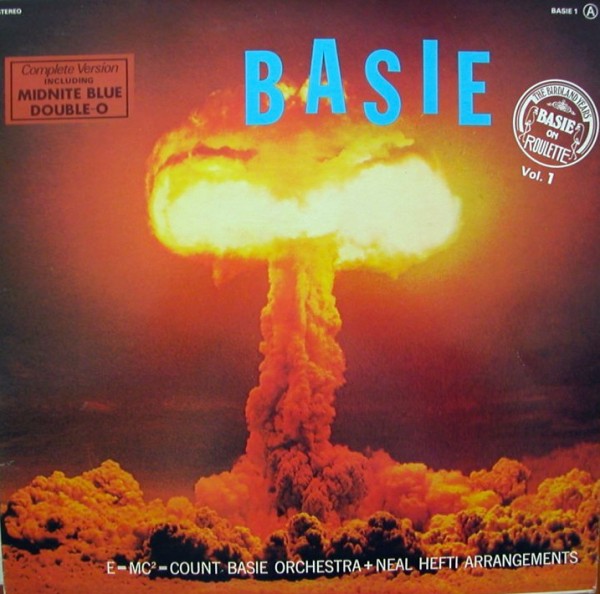
One of the first commercial uses of a fiery mushroom cloud to sell something unrelated to mushroom clouds — in this case, Count Basie’s 1958 album, Basie. The test is Operation Plumbbob, shot Hood.
Fortunately, I think, these obvious ruts paradoxically create new opportunities for people who want to educate about the bomb. It is one of the ironies of history that the more firmly entrenched an existing narrative gets, the more interested people are in compelling counter-narratives. The fact that there is a rut in the first place means that there is already a built-in audience (as opposed to history that people just don’t know anything about), and if you can find something new to say about that history, then they’re interested.
“New” here can also mean “new to them,” as opposed to “new to people who spend their lives looking at this stuff.” This is what I was talking about when I was quoted in the New York Times a few weeks ago — things that known to scholars are being discovered and re-discovered by mass audiences who are surprised to find how many different and apparently novel photographs and stories are out there.
As an aside, if I were going to give graphic designers a set of “mushroom cloud use guidelines,” they would be, more or less: 1. don’t use the first cloud you find (there are so many unusual and dramatic ones out there, if you poke around a little bit); 2. don’t use extremely historically-specific clouds (i.e. Hiroshima and Nagasaki) as generic images; 3. don’t use multi-megaton shots (i.e. giant red/orange/yellow cloud fireballs) if you are talking about kiloton-range weapons (i.e. terrorist bombs); and 4. if you are going to label something as British, make sure it is not actually French!
As part of my annual contribution to people becoming better acquainted with “new” mushroom cloud photographs, I have released a new and updated version of my Nuclear Testing Calendar for 2015. It features 12 unusual photographs of nuclear detonations, all of which I have carefully cleaned up to remove scratches and dust spots. All of the images are courtesy of Los Alamos National Laboratory.
Here is a little preview of some of the unusual clouds you will find in this calendar:
There are also over 60 nuclear “anniversaries” noted in the calendar text itself. And because 2015 is the 70th anniversary of the Trinity test, I have also reissued last-year’s Trinity test calendar. Both calendars are being offered for $18.99. The site that publishes them, Lulu.com, also often has a lot of coupons on a regular basis — please feel free to take advantage of them! All proceeds go to offsetting the costs of my web work. More details about the calendars and other nuclear delights at my updated Calendars, gifts, tchotchkes page.
- It seems to have been made by whomever made this webpage, who seems to say (if Google Translate is to be trusted), that it was rendered using the volumetric rendering software AfterBurn.[↩]
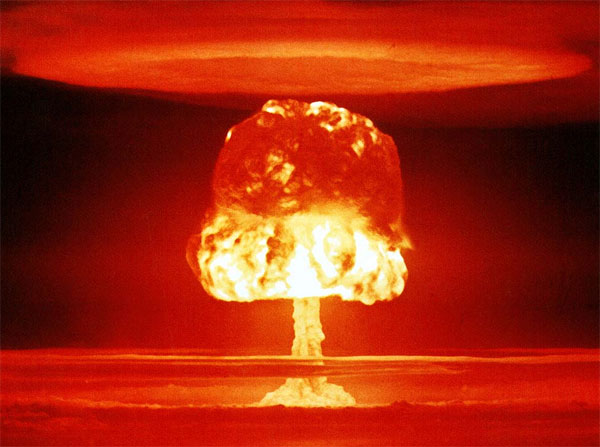

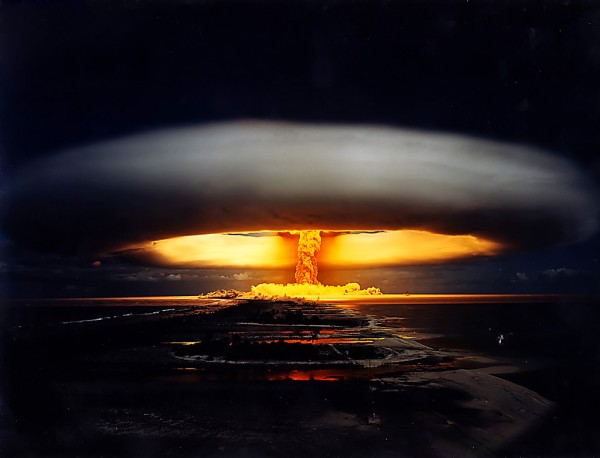
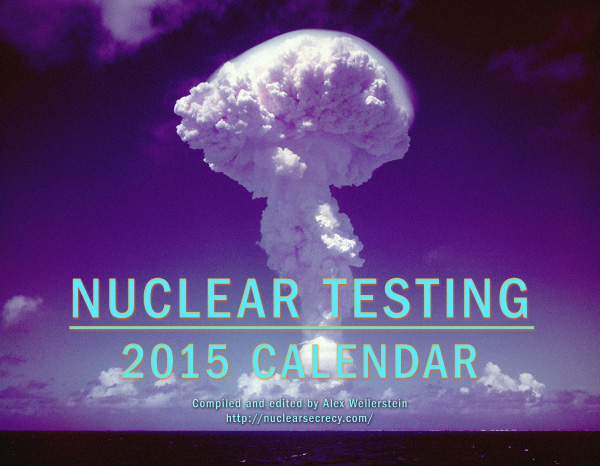
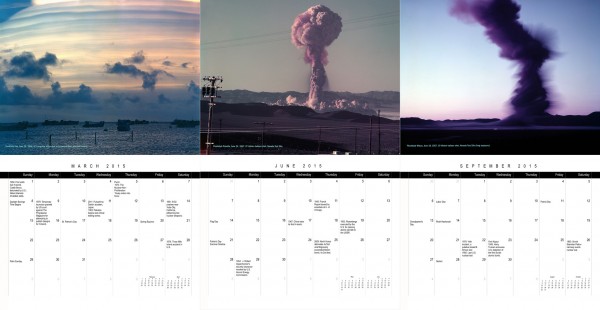


When I was going back to school several years ago, we had to take a mandatory speech class. I chose to do my speeches on nuclear weapons, the expository on history and the persuasive on the need to preserve a nuclear arsenal. I agree with you 100%, how difficult it is to find “new” atomic explosion photos. I ended up using as a backdrop of my PowerPoint for the expository an airborne shot of the “Mike” shot, it being the only “new” shot I could find after several hours of scouring the web and weeding out the CGIs and mislabled shots.
What an interesting page! I wish I’d known of it back then. 🙂 Keep up the quality work!
Alex:
New is over-rated. I prefer the classics. Used Crossroads Baker on the cover of Better Safe than Sorry: The Ironies of Living with the Bomb, and never looked back. A talented artist from the Bay Area, Mildred Howard, added coloration and a bit of digital enhancement. As Paul Newman once said (with respect to extramarital affairs), why eat hamburger out when you can have steak at home?
Michael
Michael: My main problem with the use/overuse of Baker is that it is such a specific cloud! Most nukes are unlikely to be “low”-yield shallow-underwater bursts. (In the movie World War Z, a helicopter flies over a nuclear explosion, which is clearly just the Baker shot superimposed in the frame; I kept thinking, “why would anybody use a 20 kiloton underwater shot during the zombie apocalypse? It’s only useful effect is radiological contamination, and zombies probably don’t care about radiation…”)
Being a Bomb Nerd, I deeply sympathize with you Alex, but…nobody cares! One of the things that made Gene Roddenberry the most successful (well…eventually) popularizer of science fiction among the masses was his insistence that an absolute minimum of screen time be spent pontificating about technology. “Tell your story about people, not about science and gadgetry,” the Star Trek writer’s guide famously said. “Joe Friday doesn’t stop to explain the mechanics of his .38 before he uses it; Kildare never did a monologue about the theory of anesthetics; Matt Dillon never identifies and discusses the breed of his horse before he rides
off on it.”
This is the reality of successful popular entertainment…but I’ve always been more of an “Andromeda Strain” person than a “Start Trek” person; I suspect the same could be said for you!
How about suggesting to FAS or somebody that they start an online archive of authenticated, documented mushroom cloud pictures on their existing site? It would need a gatekeeper, and you’d be the obvious choice.
It would be a neat project. There are some websites out there (like the previously-linked Sonicbomb.com) that have pretty impressively large collections of mushroom cloud photos. The difficulty is usually getting them in sufficiently high resolution. I have quite a number of them now collected from various sources, but it would be nice (though something of a chore) to get them all online and usefully organized/tagged/cleaned up. What I’d also really like clarified are the copyright statuses of non-US shots; the US shots are all pretty clearly in the public domain as works of the federal government (though sometimes even there contracting questions can complicate that sort of thing), but I don’t know about other countries. There is also quite a large repository of nuclear testing films that have been released that could be usefully hosted somewhere (a lot of them are on YouTube but not the greatest quality).
I know FAS has been doing some work towards developing a sort of “hub” on the web for nuclear education and media information, so maybe this sort of thing might end up being part of that, if funding were available (this is the sort of work that hiring some work-study undergraduates would greatly expedite).
Years ago, perhaps the reason for “everyone using the same image” was because that’s the only image the stock photo houses had.
Back in 1981 I was one of a group of MIT dropouts who started a company (General Computer Company) to do video game design. Our first game was Super Missile Attack, an enhancement kit for Atari’s Missile Command.
We had a great idea for our first print ad, using a mushroom cloud as a backdrop. This was 1981, so how do you find a high-resolution photo suitable for magazine artwork? We contacted a stock photo house and they (for a price) sent us four slides, which had various DOE and AEC identification numbers on them. (I still have them, somewhere.)
One was a classic black-and-white Hiroshima image, not very suitable for our ad. We ended up using a colorful image from Nevada Test Site. You can see a low-res version of our ad here.
Thanks to Alex I’ve identified this as Operation Plumbbob shot Owens.
Very few mushroom cloud photos show enough background to give one a sense of scale. Shot Baker is an obvious exception, but it wasn’t a typical detonation.
I feel the same way about pretty much all older military footage and its use, it’s not just mushroom clouds. Clips or picutres get used more because they look good, are in color, or whatever other reason, rather than being accurate to the material being discussed. I don’t know how many times I’ve been watching a documentary and seen incorrect film clips for the subject. For example, a documentary about the battle of Britain sneaks in gun camera footage of a Mitsubishi Zero being shot down, and other such things. It was a neat clip, but it didn’t happen over England!
BTW, I ordered one of your calendars on the spot after reading your post, I can’t wait to see it!
Alex,
I’m sympathetic with your irritation about discrepancy. Your simulator is one of the only ways to show someone how meaningless something like the Tsar Bomb really is. Even the Soviets said “Well, I guess we can make half of it out of lead, who needs that extra 50MT to demonstrate our strength?” The Tsar Bomb is simply so large, it really is beyond most comprehension, even for people familiar with the power of the weapon. There is really just nothing you could detonate it next to, viewed from 60 miles, which has meaning. There is even some dramatic footage of the ‘Largest Glaciation Event Ever Filmed!” which used the overlay of Manhattan to give scale to the event. The Tsar Bomb renders scales like this meaningless. In terms of hierarchy of scale, attempting to understand such a thing illustrates the absurdity of very large nuclear weapons, and their existence in large numbers at all.
The Licorne photos are some of the most beautiful photos ever. It really seems like something The Internet would accuse of being shot in overdone HDR.
As a warship buff, seeing Baker is fascinating. Beyond the age of widespread nuclear torpedoes and ‘Hedgehog’-type weapons, a shot like this will never take place in anger. But to see the diminutive mushroom cloud as it lifts the Arkansas gives scale to Hiroshima and Nagasaki. The original footage we’ve seen of the combat drops is so hazy, it’s easy to imagine the Hiroshima bomb destroying the entire city. Not true. The weapon was small enough that large numbers of people survived… the initial blast, to be killed or maimed by later horrors. In a way, the surprisingly small scale of a low kt weapon is really more frightening. It’s something you can use on a task force of ships, or perhaps to punish your enemies to demonstrate your power. Yet it’s likely to trigger a massive response, and the casualties will be horrific.
I confess to a morbid fascination with the footage and photos of this kind of destruction. I suppose that’s why we’re all here. The unsurprising benefit is that in attempting to understand the weapons, I have much stronger convictions about them never being used.
Always fascinated by your blog and site, Alex.
Like many here have said, We’re sympathetic with your irritation about discrepancies.
One of the most irritatingly endemic misidentifications, to me, is that of the 1.6 Mt shot Castle Nectar, being presented as shot Castle Bravo (15 Mt). Numerous high budget documentaries which I’ve listed below* and youtube videos of the ‘largest man-made explosions ever’ misidentify it.
I won’t bore you with the details of how I came about discovering this discrepancy and positively identifiying the often presented video as Nectar, and not Bravo, as it is all detailed in the below linked wikipedia edit conflict that was positively resolved, if anyone’s really interested.
Suffice it to say however, even the declassified films made by the Lookout Mountain Air Force station are to blame for having misled people for decades. As the declassified video is presented in such a way that it’s understandable why so many folks have come to the incorrect conclusions that it is Castle Bravo they’re looking at and not the much smaller Castle Nectar fireball.
https://en.wikipedia.org/wiki/Talk:Enewetak_Atoll#Castle_video_under_question.2C_is_it_shot_Nectar_or_Bravo.3F
*
The otherwise excellent 1986’s ‘Trinity and Beyond – The Atomic Bomb Movie’ – a USA documentary by Peter Kuran.
The 1999 ‘Race for the Super Bomb’ produced by PBS
The 2011’s ‘Secrets of the Dead: the World’s Biggest Bomb’ again produced by PBS
and which also misidentifies the footage as Castle Bravo.